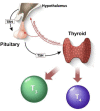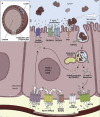Genetics of congenital hypothyroidism: Modern concepts
- PMID: 35774517
- PMCID: PMC9218988
- DOI: 10.1002/ped4.12324
Genetics of congenital hypothyroidism: Modern concepts
Abstract
Congenital hypothyroidism (CH) is the most common neonatal endocrine disorder and one of the most common preventable causes of intellectual disability in the world. CH may be due to developmental or functional thyroid defects (primary or peripheral CH) or be hypothalamic-pituitary in origin (central CH). In most cases, primary CH is caused by a developmental malformation of the gland (thyroid dysgenesis, TD) or by a defect in thyroid hormones synthesis (dyshormonogenesis, DH). TD represents about 65% of CH and a genetic cause is currently identified in fewer than 5% of patients. The remaining 35% are cases of DH and are explained with certainty at the molecular level in more than 50% of cases. The etiology of CH is mostly unknown and may include contributions from individual and environmental factors. In recent years, the detailed phenotypic description of patients, high-throughput sequencing technologies, and the use of animal models have made it possible to discover new genes involved in the development or function of the thyroid gland. This paper reviews all the genetic causes of CH. The modes by which CH is transmitted will also be discussed, including a new oligogenic model. CH is no longer simply a dominant disease for cases of CH due to TD and recessive for cases of CH due to DH, but a far more complex disorder.
Keywords: Congenital hypothyroidism; Development; Dyshormonogenesis; Genetic; High‐throughput sequencing; Oligogenism; Thyroid dysgenesis.
© 2022 Chinese Medical Association. Pediatric Investigation published by John Wiley & Sons Australia, Ltd on behalf of Futang Research Center of Pediatric Development.
Conflict of interest statement
The authors declare no conflict of interest.
Figures





Similar articles
-
New genetics in congenital hypothyroidism.Endocrine. 2021 Mar;71(3):696-705. doi: 10.1007/s12020-021-02646-9. Epub 2021 Mar 1. Endocrine. 2021. PMID: 33650047 Review.
-
[Genetic of congenital hypothyroidism].Med Sci (Paris). 2022 Mar;38(3):263-273. doi: 10.1051/medsci/2022028. Epub 2022 Mar 25. Med Sci (Paris). 2022. PMID: 35333163 French.
-
Genetic Defects in Thyroid Hormone Supply.2018 Jan 12. In: Feingold KR, Ahmed SF, Anawalt B, Blackman MR, Boyce A, Chrousos G, Corpas E, de Herder WW, Dhatariya K, Dungan K, Hofland J, Kalra S, Kaltsas G, Kapoor N, Koch C, Kopp P, Korbonits M, Kovacs CS, Kuohung W, Laferrère B, Levy M, McGee EA, McLachlan R, Muzumdar R, Purnell J, Rey R, Sahay R, Shah AS, Singer F, Sperling MA, Stratakis CA, Trence DL, Wilson DP, editors. Endotext [Internet]. South Dartmouth (MA): MDText.com, Inc.; 2000–. 2018 Jan 12. In: Feingold KR, Ahmed SF, Anawalt B, Blackman MR, Boyce A, Chrousos G, Corpas E, de Herder WW, Dhatariya K, Dungan K, Hofland J, Kalra S, Kaltsas G, Kapoor N, Koch C, Kopp P, Korbonits M, Kovacs CS, Kuohung W, Laferrère B, Levy M, McGee EA, McLachlan R, Muzumdar R, Purnell J, Rey R, Sahay R, Shah AS, Singer F, Sperling MA, Stratakis CA, Trence DL, Wilson DP, editors. Endotext [Internet]. South Dartmouth (MA): MDText.com, Inc.; 2000–. PMID: 25905381 Free Books & Documents. Review.
-
Genetics of Primary Congenital Hypothyroidism.Pediatr Endocrinol Rev. 2018 Mar;15(3):200-215. doi: 10.17458/per.vol15.2018.zst.geneticsprimaryhypothyroidism. Pediatr Endocrinol Rev. 2018. PMID: 29493125 Review.
-
The mutation screening in candidate genes related to thyroid dysgenesis by targeted next-generation sequencing panel in the Chinese congenital hypothyroidism.Clin Endocrinol (Oxf). 2022 Apr;96(4):617-626. doi: 10.1111/cen.14577. Epub 2021 Aug 9. Clin Endocrinol (Oxf). 2022. PMID: 34374102
Cited by
-
Late-onset dyshormonogenic goitrous hypothyroidism due to a homozygous mutation of the SLC26A7 gene: a case report.Ital J Pediatr. 2024 May 29;50(1):106. doi: 10.1186/s13052-024-01672-3. Ital J Pediatr. 2024. PMID: 38812002 Free PMC article.
-
Newborn screening for congenital hypothyroidism: worldwide coverage 50 years after its start.Eur Thyroid J. 2025 Jan 31;14(1):e240327. doi: 10.1530/ETJ-24-0327. Print 2025 Feb 1. Eur Thyroid J. 2025. PMID: 39812367 Free PMC article. Review.
-
Commentary on "Deciphering the mystery of CHNG3".Ann Pediatr Endocrinol Metab. 2024 Oct;29(5):277-278. doi: 10.6065/apem.2424093edi05. Epub 2024 Oct 31. Ann Pediatr Endocrinol Metab. 2024. PMID: 39506341 Free PMC article. No abstract available.
-
Evaluation of patients diagnosed with congenital hypothyroidism by newborn screening between 2011-2019 in Diyarbakir, Turkey.Medicine (Baltimore). 2023 Dec 22;102(51):e36778. doi: 10.1097/MD.0000000000036778. Medicine (Baltimore). 2023. PMID: 38134076 Free PMC article.
-
Case Report - Multinodular goiter in a patient with Congenital Hypothyroidism and Bannayan-Riley-Ruvalcaba syndrome: the possible synergic role of TPO and PTEN mutation.Front Endocrinol (Lausanne). 2023 Jun 8;14:1205785. doi: 10.3389/fendo.2023.1205785. eCollection 2023. Front Endocrinol (Lausanne). 2023. PMID: 37361526 Free PMC article.
References
-
- Léger J. Dépistage de l'hypothyroïdie congénitale [Neonatal screening for congenital hypothyroidism]. Med Sci (Paris). 2021;37:474‐481. (in French). - PubMed
-
- Trueba SS, Augé J, Mattei G, Etchevers H, Martinovic J, Czernichow P, et al. PAX8, TITF1, and FOXE1 gene expression patterns during human development: new insights into human thyroid development and thyroid dysgenesis‐associated malformations. J Clin Endocrinol Metab. 2005;90:455‐462. DOI: 10.1210/jc.2004-1358 - DOI - PubMed
Publication types
LinkOut - more resources
Full Text Sources
